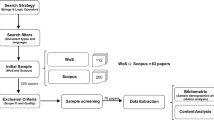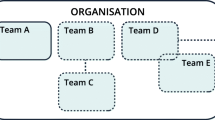Abstract
Global product development teams work in ambiguously complex dynamic networks. Characterization of the distributed work environment includes many factors, including: individuals and sub-teams are geographically distributed; they belong to different organizational cultures; they operate in different time zones and within different cultural and professional-frameworks. From a communication perspective, individual team members may speak different languages and lack a common tongue. Even in these scenarios, project teams are expected to produce quality products and bring them quickly to the market. The design-to-market life cycle has shortened markedly in the past decade in many industries. How do they manage to perform effectively in the face of these many obstacles? Development team “Coaching” has emerged as a guiding force in many project-organized environments. Individuals may have arrived at the role informally, tacitly responding to the needs of teams around them, or they are professionals with formal training as we find in SAP’s “Design Team Services” group (Plattner 2007, personal comunication). We have observed that the coach provides project team members with assistance that ranges from problem solving to moral support. In spite of the growing use of coaching, there is significant confusion about the nature of the role, the attributes of good versus poor coaching, associated terminology and definitions. We report on the development of a conceptual framework for further research in the emerging domain of design engineering coaching. Our efforts began with an extensive literature review that yielded leading candidates for role terminology and the scope of the subject. With that framework in hand, we performed a field assessment (survey) in an industry-academic environment that is noted for the extreme nature of its project-based learning paradigm and deep corporate engagement, including a mixture of industry liaisons and academic advisors who are in coaching roles. We expect the combination of methods to provide common ground for further work and to better explain the issues to students and industry partners. The resulting framework consists of five main roles that design-team coaches have been observed to assume. It is anticipated that our results will help others identify new research questions and apply an expanded set of empirical methods.







Similar content being viewed by others
Notes
Its detailed description is: “Buffers the team from the influence of external forces or events; helps different work teams communicate with one another; acts as a representative of the team with other parts of the organization…; advocates on behalf of the team to others in the organization;’ and helps to resolve difficulties between different teams.”
Online material is available at: http://www.eng.tau.ac.il/~yoram/coaching/CoachREDapp.pdf.
References
Argyris C (1977) Double loop learning in organizations. Harv Bus Rev 55(5):115–129
Bayer H (2000) Coaching-Kompetenz: Persoenlichkeit und Fuehrungspsychologie, 2nd edn. Ernst Reinhardt Verlag, München
Boyle TA (2005) Improving team performance using repertory grids. Team Perform Manage 11(5/6):179–187
Brinkmann RD (1994) Mitarbeiter-Coaching. Der Vorgesetzte als Coach seiner Mitarbeiter (Arbeitshefte Fuehrungspsychologie, Band), 22 edn. Sauer Verlag, Heidelberg
Bryman A (2004) Qualitative research on leadership: a critical but appreciative review. Leadersh Q 15:729–769
Cassell C, Close P, Duberley J, Johnson P (2000) Surfacing embedded assumptions: using repertory grid methodology to facilitate organizational change. Eur J Work Organ Psychol 9(4):561–573
Carrillo A, Carrizosa K, Leifer L (2003) Design team coaches. In: Proceedings of the 2003 American Society for Engineering Education annual conference and exposition
Cramton CD (2001) The mutual knowledge problem and its consequences for dispersed collaboration. Organ Sci 12(3):346–371
Creswell JW (2002) Research design: qualitative, quantitative, and mixed methods approaches, 2nd edn. Sage, Beverly Hills
Denison DR, Hooijberg R, Quinn RE (1995) Paradox and performance: toward a theory of behavioral complexity in managerial leadership. Organ Sci 6(5):524–540
DeRue DS, Morgeson FP (2005) Developing taxonomy of team leadership behavior in self-managing teams. Poster session presented at the 20th Annual Conference of the Society for Industrial and Organizational Psychology, Los Angeles, CA
Duarte DL, Snyder NT (2006) Mastering virtual teams, 3rd edn. Jossey-Bass, San Francisco
Eodice M (2000) A theory of requirements definition in engineering design. PhD Thesis, Stanford University, 163 p
Eriz O, Leifer L (2003) Facilitating product design knowledge acquisition: interaction between the expert and the team. Int J Eng Educ 19(1):142–152
Furst SA, Reeves M, Rosen B, Blackburn RS (2004) Managing the life cycle of virtual teams. Acad Manage Exec 18(2):6–20
Gaines BR, Shaw MLG (1996) WebGrid: knowledge modeling and inference through the World Wide Web. In: Gaines BR, Musen M (eds) Proceedings of the tenth knowledge acquisition for knowledge-based systems workshop, Banff, pp 65-1–65-14
Geva U, Van der Loos M (2005) On coaching, forming informal team relationships formally. ME310 course coaching guidelines, Stanford University, d.school
Gregoire MB, Arendt SW (2004) Leadership: reflections over the past 100 years. J Am Diet Assoc 104(3):395–403
Hackman JR, Wageman R (2005) A theory of team coaching. Acad Manage Rev 30(2):269–287
Hamann A, Huber JJ (1991) Coaching: Der Vorgesetzte als Trainer. Hoppenstedt-Technik-Tab.-Verlag, Darmstadt
Hartley J, Benington J (2000) Co-research: a new methodology for new times. Eur J Work Organ Psychol 9(4):463–476
Hinds P, Pfeffer J (2003) Why organizations don′t “know what they know”: cognitive and motivational factors affecting the transfer of expertise. In: Ackerman M, Pipek V, Wulf V (eds) Sharing expertise—beyond knowledge management. The MIT Press, Cambridge, pp 4–26
House RJ, Aditya RN (1997) The social scientific study of leadership: Quo Vadis? J Manage 23(3):409–473
Huck H (1989) Coaching. In: Strutz H (ed) Handbuch Personalmarketing. Gabler, Wiesbaden, pp 413–420
Ingram H, Desombre T (1999) Teamwork: comparing academic and practitioners’ perceptions. Team Perform Manage 5(1):16–22
Jones RL, Wallace M (2005) Another bad day at the training ground: coping with ambiguity in the coaching context. Sport Educ Soc 10(1):119–134
Jünemann E, Lloyd B (2003) Consulting for virtual excellence: virtual teamwork as a task for consultants. Team Perform Manage 9(7–8):182–189
Kayworth TR, Leidner DE (2001) Leadership effectiveness in global virtual teams. J Manage Inf Syst 18(3):7–40
Katzenbach JR, Smith DK (1993) The discipline of teams. Harv Bus Rev 71(2):111–120
Kelly G (1955) The psychology of personal constructs, vol 1, 2. Norton, New York
Kim Y, Min B, Cha J (1999) The roles of R&D team leaders in Korea: a contingent approach. R&D Manage 29(2):153–166
Leifer LJ (1998) Design team performance: metrics and the impact of technology. In: Brown SM, Seidner C (eds) Evaluating organizational training. Kluwer, Dordrecht
Lipnack J, Stamps J (1997) Virtual teams: reaching across space, time, and organizations with technology. Wiley, New York
Lloyd B (2005) Coaching, culture and leadership. Team Performance Manage 11(3–4):133–138
Looss W (1997) Unter vier Augen. Verlag Moderne Industrie, Landsberg/Lech
Nair A (2008) Meta-analysis of the relationship between quality management practices and firm performance—implications for quality management theory development. J Oper Manage (in press)
Pearce CL, Sims HP Jr, Cox JF, Ball G, Schnell E, Smith KA, Trevino L (2003) Transactors, transformers and beyond: a multi-method development of a theoretical typology of leadership. J Manage Dev 22(4):273–307
Perry TS (1995) How small firms innovate: designing a culture for creativity. Res Technol Manage, March–April, pp 14–17
Rauen C (2003) Coaching, 3rd edn. Hogrefe-Verlag, Goettingen
Reich Y (2000) Improving the rationale capture capability of QFD. Eng Comput 16(3–4):236–252
Reich Y, Kapeliuk A (2005) A framework for organizing the space of DSS with application to solving subjective, context dependent problems. Decis Support Syst 41(1):1–19
Reich Y, Ullmann G, Van der Loos M, Leifer L (2007) Perceptions of coaching in product development teams. in: CDROM Proceedings of the 16th international conference on engineering design (ICED), The Design Society
Rueckle H (2000) Coaching. So spornen Manager sich und andere zu Spitzenleistungen an. Verlag Moderne Industrie, Landsberg/Lech
Sargent P, Subrahmanian E, Downs M, Greene R, Rishel D (1992) Materials’ information and conceptual data modeling. in: Barry TI, Reynard KW (eds) Computerization and networking of materials databases: third volume, ASTM STP 1140. American Society For Testing and Materials
Schmidt G (1995) Business Coaching: Mehr Erfolg als Mensch und Macher. Gabler, Wiesbaden
Schreyoegg A (1995) Coaching. Eine Einfuehrung fuer Praxis und Ausbildung. Campus Verlag, Frankfurt/M
Schwarz R (2002) The skilled facilitator—a comprehensive resource for consultants, facilitators, managers, trainers, and coaches, 2nd edn. Jossey-Bass, San Francisco
Senior B, Swailes S (2004) The dimensions of management team performance: a repertory grid study. Int J Prod Perform Manage 53(4):317–333
Shai O, Reich Y, Rubin D (2008) Creative conceptual design: extending the scope by infused design. Comput Aided Des (in press)
Shaw MLG, Gaines BR (1989) Comparing conceptual structures: consensus, conflict, correspondence and contrast. Knowl Acquis 1(4):341–363
Smith PG, Blanck EL (2002) From experience: leading dispersed teams. J Prod Innov Manage 19:294–304
Stewart GL (2006) A meta-analytic review of relationships between team design features and team performance. J Manage 32(1):29–55
Tuckman BW (1965) Developmental sequence in small groups. Psychol Bull 63(6):384–399
Weiss J (1993) Selbst-Coaching. Persoenliche Power und Kompetenz gewinnen, 4th edn. Junfermann, Paderborn
Werth L, Markel P, Forster J (2006) The role of subjective theories for leadership evaluation. Eur J Work Organ Psychol 15(1):102–127
Whitmore J (1994) Coaching fuer die Praxis—Eine klare, praegnante und praktische Anleitung fuer Manager, Trainer, Eltern und Gruppenleiter. Campus Verlag, Frankfurt/ Main
Author information
Authors and Affiliations
Corresponding author
Electronic supplementary material
Below is the link to the electronic supplementary material.
Appendix A: Final coaching clusters
Appendix A: Final coaching clusters
This appendix provides a detailed description of each coaching cluster (Tables 9, 10, 11, 12 and 13).
Rights and permissions
About this article
Cite this article
Reich, Y., Ullmann, G., Van der Loos, M. et al. Coaching product development teams: a conceptual foundation for empirical studies. Res Eng Design 19, 205–222 (2009). https://doi.org/10.1007/s00163-008-0046-1
Received:
Revised:
Accepted:
Published:
Issue Date:
DOI: https://doi.org/10.1007/s00163-008-0046-1




